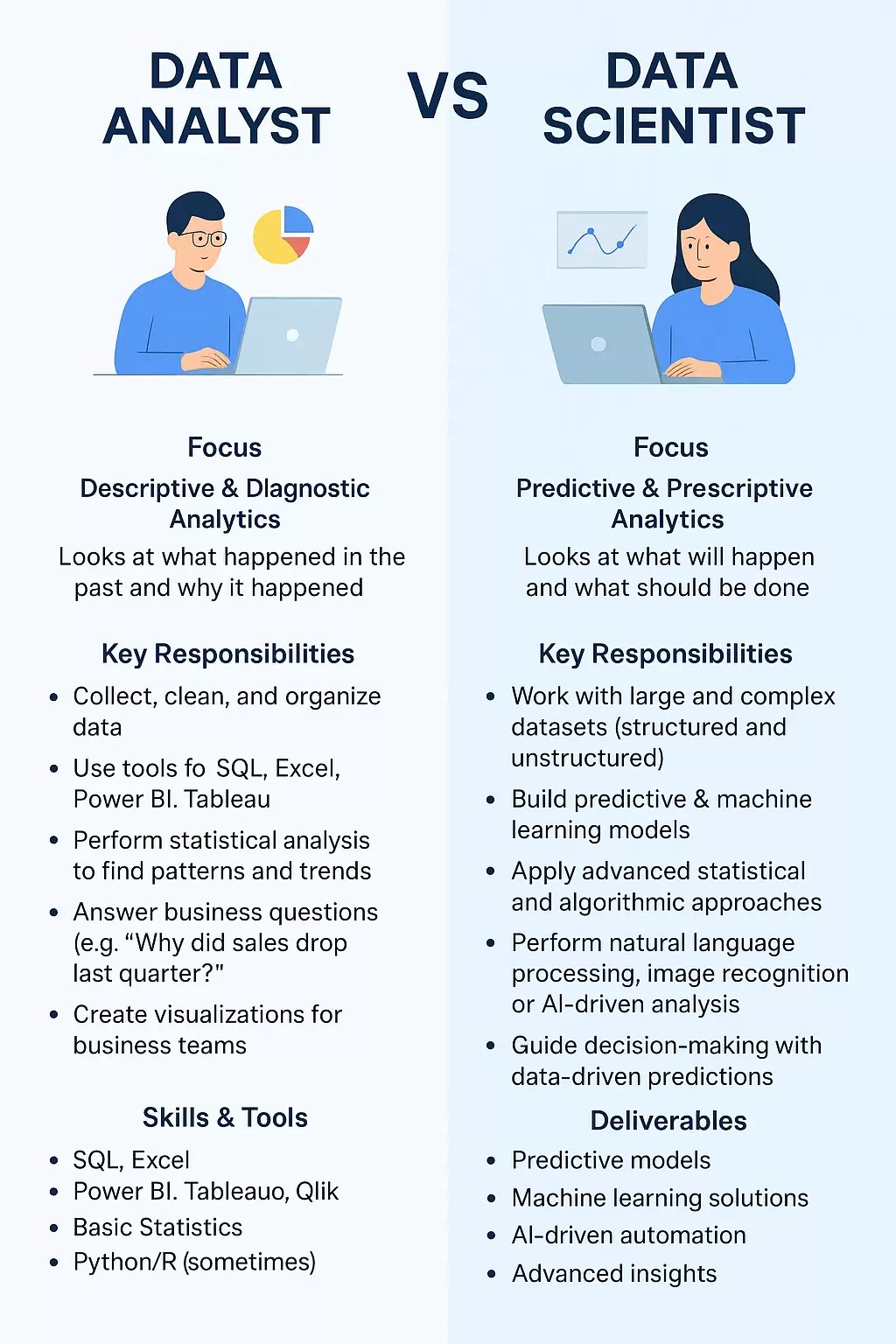People often get confused with the roles of a Data Analyst and a Data Scientist. The roles of a data analyst and a data scientist differ primarily in their focus, the complexity of their work, and the tools they use. While both roles work with data to derive insights, a data analyst typically focuses on descriptive and diagnostic analytics (what happened and why), whereas a data scientist specializes in predictive and prescriptive analytics (what will happen and what to do about it)
🔹 Data Analyst
A data analyst’s main goal is to interpret historical data to identify trends. They communicate findings to stakeholders to support business decisions. They work with structured, clean data and often create reports, dashboards, and visualizations.
Focus: Descriptive & Diagnostic Analytics
👉 Looks at what happened in the past and why it happened.
Key Responsibilities
- Collect, clean, and organize structured data
- Use tools like SQL, Excel, Power BI, Tableau to generate reports & dashboards
- Perform statistical analysis to find patterns and trends
- Answer business questions (e.g., “Why did sales drop last quarter?”)
- Create visualizations for business teams
- Communicating insights to non-technical business teams.
Skills & Tools
- SQL, Excel
- Power BI, Tableau, Qlik
- Basic Statistics
- Python/R (sometimes)
Deliverables
- Reports
- Dashboards
- KPIs & Metrics tracking
- Business Insights
🔹 Data Scientist
A data scientist’s role is more experimental and research-oriented. They go beyond analyzing past data to build complex models and algorithms that can forecast future outcomes and automate decisions. They often work with large, unstructured datasets.
Focus: Predictive & Prescriptive Analytics
👉 Looks at what will happen and what should be done
Key Responsibilities
- Work with large and complex datasets (structured + unstructured)
- Build predictive & machine learning models
- Apply advanced statistical and algorithmic approaches
- Conducting research and applying the scientific method to prove hypotheses.
- Perform natural language processing, image recognition, or AI-driven analysis
- Guide decision-making with data-driven predictions (e.g., “Which customers are likely to churn?”)
Skills & Tools
- Python, R, SQL
- Machine Learning (Scikit-learn, TensorFlow, PyTorch)
- Data Engineering concepts (Spark, Databricks, Hadoop)
- Statistics & Probability (hypothesis testing, regression, etc.)
- Cloud platforms (Azure, AWS, GCP)
Deliverables
- Predictive Models
- Machine Learning Solutions
- AI-driven automation
- Advanced Insights
⚖️ Key Difference
| Aspect | Data Analyst 🧑💻 | Data Scientist 👩🔬 |
|---|---|---|
| Goal | What happened and why? (Descriptive & Diagnostic) | What will happen and what should we do? (Predictive & Prescriptive) |
| Data Type | Mostly structured | Structured + unstructured (text, images, audio) |
| Tools | SQL, Excel, Tableau, Power BI | Python, R, Spark, machine learning frameworks, and cloud computing |
| Complexity | Low to Medium | High |
| Output | Reports, dashboards, insights | Predictive models, ML algorithms |

✅ Simple Analogy:
An analogy is the difference between a general practitioner and a specialist. A data analyst is like a GP (general practitioner). They diagnose current issues based on symptoms (historical data). Then, they prescribe a course of action.
A data scientist is a specialist. They use advanced tools and research. Their goal is to build a model that can predict a disease (future trend) and develop new treatments (prescriptive solutions).
To know more about Data analysis, please refer to the following article Comprehensive Guide to Data Analysis
Discover more from Technology with Vivek Johari
Subscribe to get the latest posts sent to your email.



